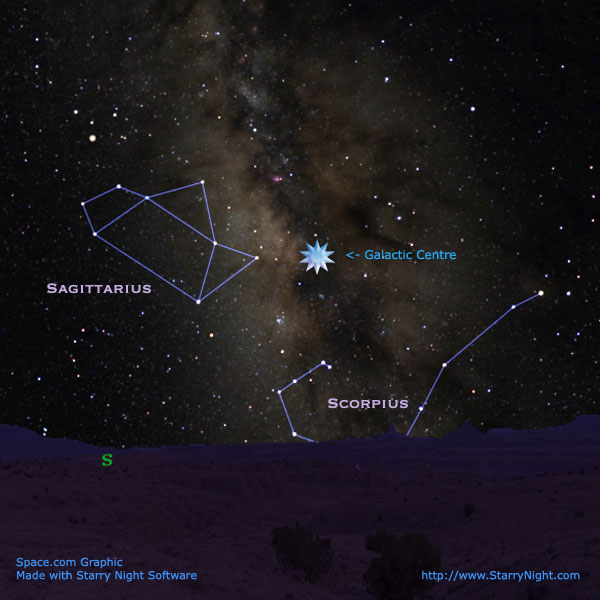
The same new moon that sets up the total solareclipse Aug. 1 will create dark night-sky conditions for stargazing, makingthis a great time to check out the beautiful midsummer Milky Way.
Campers and rural residents should have littletrouble spotting it, weather permitting.
As soon as darkness falls, the Milky Way becomesevident as a wide glowing arch of variety and beauty, stretching high acrossthe sky from the northeast to southwest.
Sweep with binoculars up from the tail of theconstellation Scorpius, low in the southwest through the Summer Triangle,almost overhead and down toward Cassiopeia and Perseus in the northeast. You'llfind concentrations of stars, clusters, large apparent gaps such as the GreatRift in Cygnus, and more stars than you thought existed.
Never visible from large cities with their bright lights,smoke and haze, the Milky Way canstill be readily viewed from distant suburbs and rural locations. Visually itappears as a faint, albeit distinct ghostly band of light; it almost looks more"smoky" than "milky" in appearance. From a truly dark site,however, it appears in full glory: The brightest portions can cast faintshadows, and it appears highly complex and structuredto the unaided eye and like veined marble when viewed with ordinary binoculars.
What it is
Before the invention of the telescope, the true nature ofthe Milky Way Galaxy ("Gala" is Greek for milk) was a mystery. Now weknow it's a concentration of stars in our own galaxy.
Get the Space.com Newsletter
Breaking space news, the latest updates on rocket launches, skywatching events and more!
The galaxy's center is about 26,000 light-years away towardthe Sagittarius star cloud. From where we sit, the galaxy's outer edge is about20,000 light-years in the opposite direction (toward Auriga and Taurus). We resideon a spur of the Orion arm, and what we see as we look at the Milky Way in ournight sky is just a portion of nearest stars between us and the galactic center.
The sun and all the outer stars of the galaxy revolve aroundthe galacticcenter at the rate of 155 miles per second. It apparently requires about225 million of our earthly years to make one complete revolution, or one "cosmicyear," around the center of our galaxy.
When we began to realize that there were other suchvast collections or aggregation of stars, we called them "islanduniverses," but this was an obvious misnomer; since universe meanseverything there is, it can hardly have a plural. So we've seemed to havesettled on "galaxies," which is a compromise as a new meaning for an old word.
What was that eerie cloud?
Unfortunately, because of the tremendous increase in lightpollution over the past quarter century, the majority of our current generationhave never seen the night sky in allits grandeur.
In his book "Nightwatch," the well-known Canadianastronomer Terrence Dickinson comments that in the aftermath of the predawn1994 Northridge, California earthquake, electrical power was knocked out over awide area. Tens of thousands of people in southern California rushed out oftheir homes looked up and perhaps for the first time in their lives saw a dark,starry sky. In the days and weeks that followed, radio stations andobservatories in the Los Angeles area received countless numbers of phone callsfrom concerned people who wondered whether the sudden brightening of the starsand the appearance of an eerie silvery cloud (the Milky Way) might have causedthe quake.
"Such reaction," notes Dickinson, "can comeonly from people who have never seen the night sky away from city lights."
- SolarEclipse Friday to Fascinate Millions
- MilkyWay: Best of Your Photos
- The New Tourist's Guide to the Milky Way
- Milky Way Loses Two Arms
Joe Rao serves as an instructor and guest lecturer at New York's Hayden Planetarium. He writes about astronomy for The New York Times and otherpublications, and he is also an on-camera meteorologist for News 12 Westchester, New York.
Join our Space Forums to keep talking space on the latest missions, night sky and more! And if you have a news tip, correction or comment, let us know at: community@space.com.

Joe Rao is Space.com's skywatching columnist, as well as a veteran meteorologist and eclipse chaser who also serves as an instructor and guest lecturer at New York's Hayden Planetarium. He writes about astronomy for Natural History magazine, Sky & Telescope and other publications. Joe is an 8-time Emmy-nominated meteorologist who served the Putnam Valley region of New York for over 21 years. You can find him on Twitter and YouTube tracking lunar and solar eclipses, meteor showers and more. To find out Joe's latest project, visit him on Twitter.









